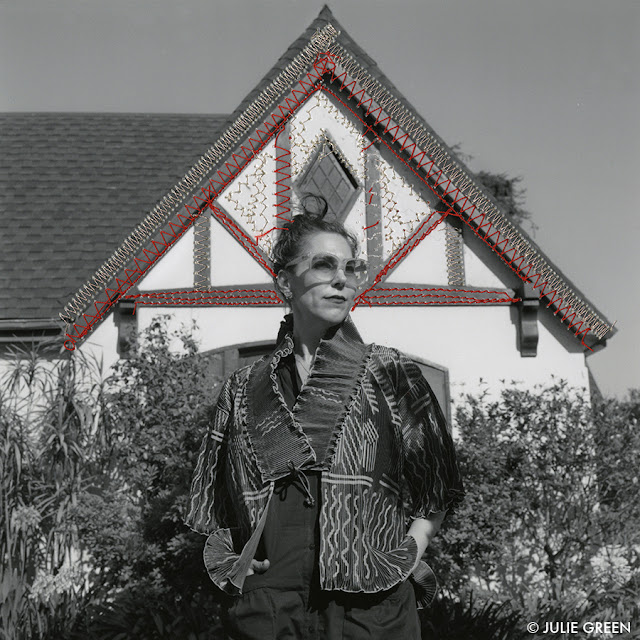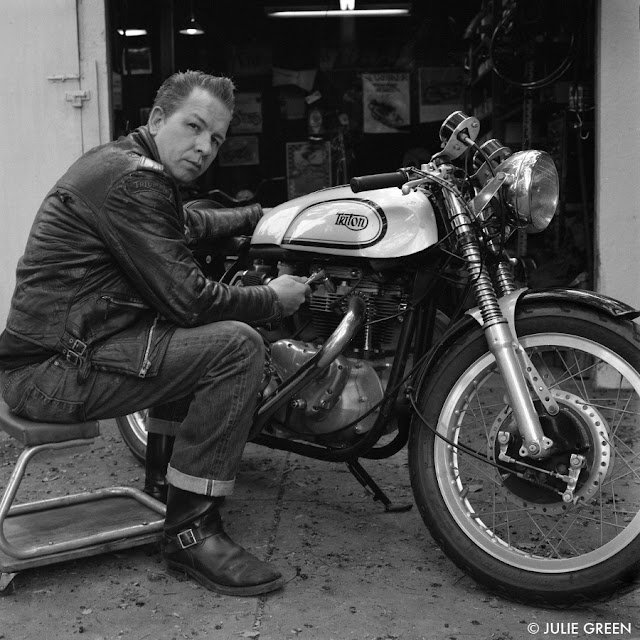Patterns and Tones will be back in February just in time to celebrate our 3rd year anniversary of bringing images to you weekly.
All my very best,
Julie Green
December 26, 2015
 |
| "Amanda Quinn Olivar" from the series Home as Hat
While I was photographing Kim Shattuck for my "Day in the Life of a Rock n' Roller" series back in March, a new body of work emerged. As we were walking around Kim's neighborhood with her sweet pup, we suddenly passed a home with a portico that just begged to be in the background. I ended up positioning her under the distant porch covering and a new series of portraits was born.
"Home as Hat" consists so far of six lovely ladies and a couple underneath various entryways. The "hats" range from rounded colonial style awnings, and late 40's transoms, to pointed rooftops in the background, which when positioned just right takes on the shape of a hat. I have spent a long time thinking about how I would emphasis the "hat" in each photograph and came up with the idea of sewing the photographic paper directly with thread. I felt it was important for the hat to be three dimensional so it would tie the images together and emphasis the architectural shape. The symbology in this body of work can be seen in the stitches binding us together, the home as comfort and security, and the hat as a protective covering from the elements. It has been fun stitching on paper. I actually created all of my wedding invitations by stitching the information onto card stock. I was facinated with the symbology of "tying the knot" and wanted to emphasis our union. I used silver thread for those invitations and applied it to these images you see here as well. The thread is very fine and doesn't bunch up while sewing it onto paper. Each of my subjects are very fashion forward ladies who I specifically selected to pose for this project. I knew their distinctive style would add to the fashion element I was trying to emphasis in this series. These are women I look up to and admire, an emotion which I hope comes through as another element in this body of work. Today I present to you the evolution of my first decorative "hat", featuring the lovely and amazing Amanda Quinn Olivar.
With a tip of my hat to all of you, Happy Holidays!
Julie Green
December 19, 2015
|
 |
| "Jonnie Green from Tonup Classics No.1" |
 |
| "Jonnie Green from Tonup Classics No.7" |
 |
| "Jonnie Green from Tonup Classics No.10" |
 |
| "Jonnie Green from Tonup Classics No.16"
JKG: Have you ever raced a motorcycle?
JG: No, only bar hopping with me mates after dark.
JKG: You also sell motorcycle items on eBay under Manxtt. What is the coolest item you've ever listed?
JG: That's a hard one. Over the years since I have been selling I have had some super cool items pass through my hands. Some of the Clash Posters I sold for Pearl Harbour come to mind. An original Motor Maids uniform that I sold 15 or so years ago was very cool. I love all the memorabilia that I have dealt with over the years, not to mention rare vintage parts and bikes.
JKG: You attend a lot of auctions and swap meets. How has the motorcycle business changed over the years?
JG: Ebay was obviously the big game changer in recent years, although social media plays a large part in a lot of trading now a days. As far as trends go, original unrestored machines, whether auto or motorcycle, plane or train, are becoming more popular than restored machines. I am 110% behind this trend as my own personal collection reflects.
They are only original once!
|